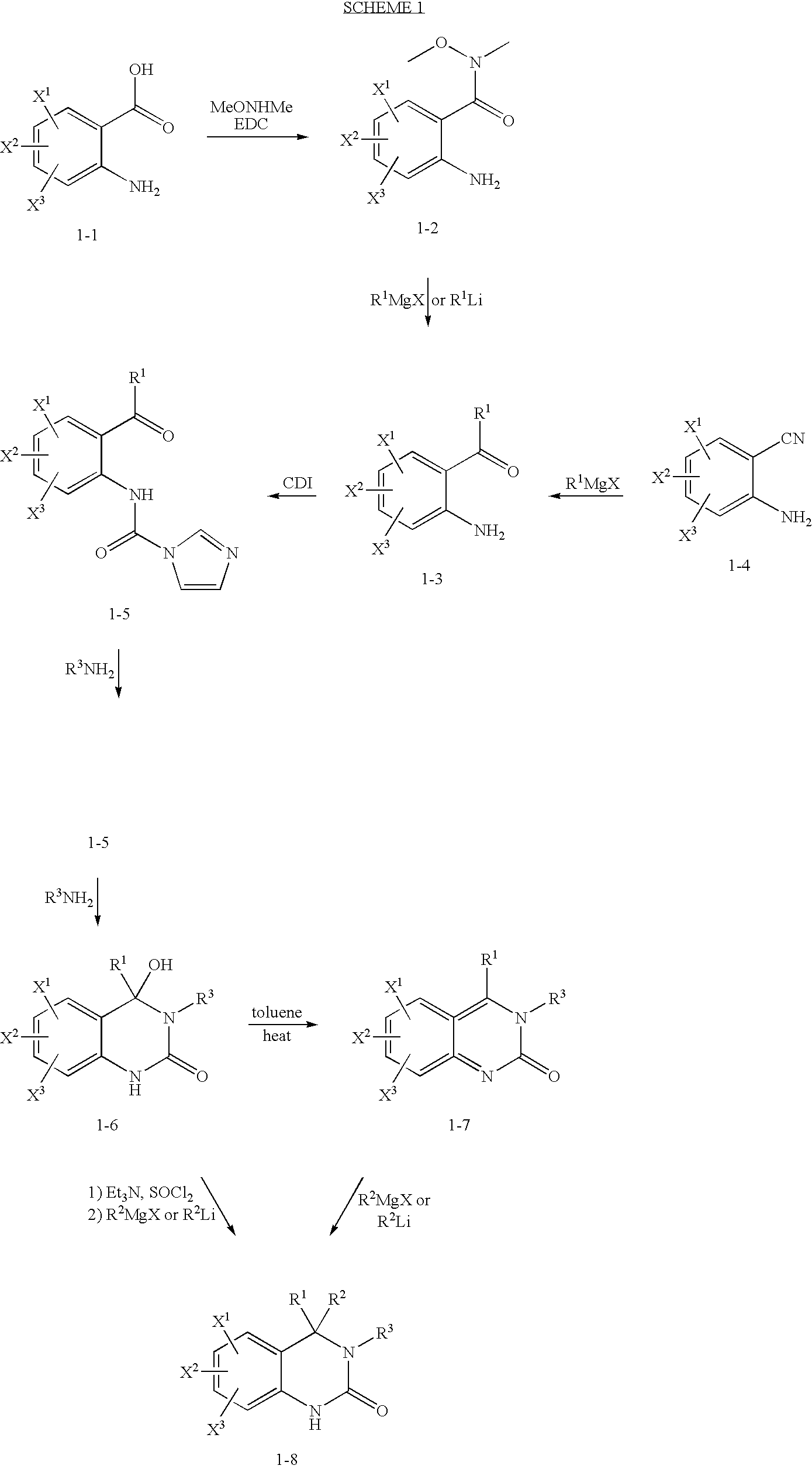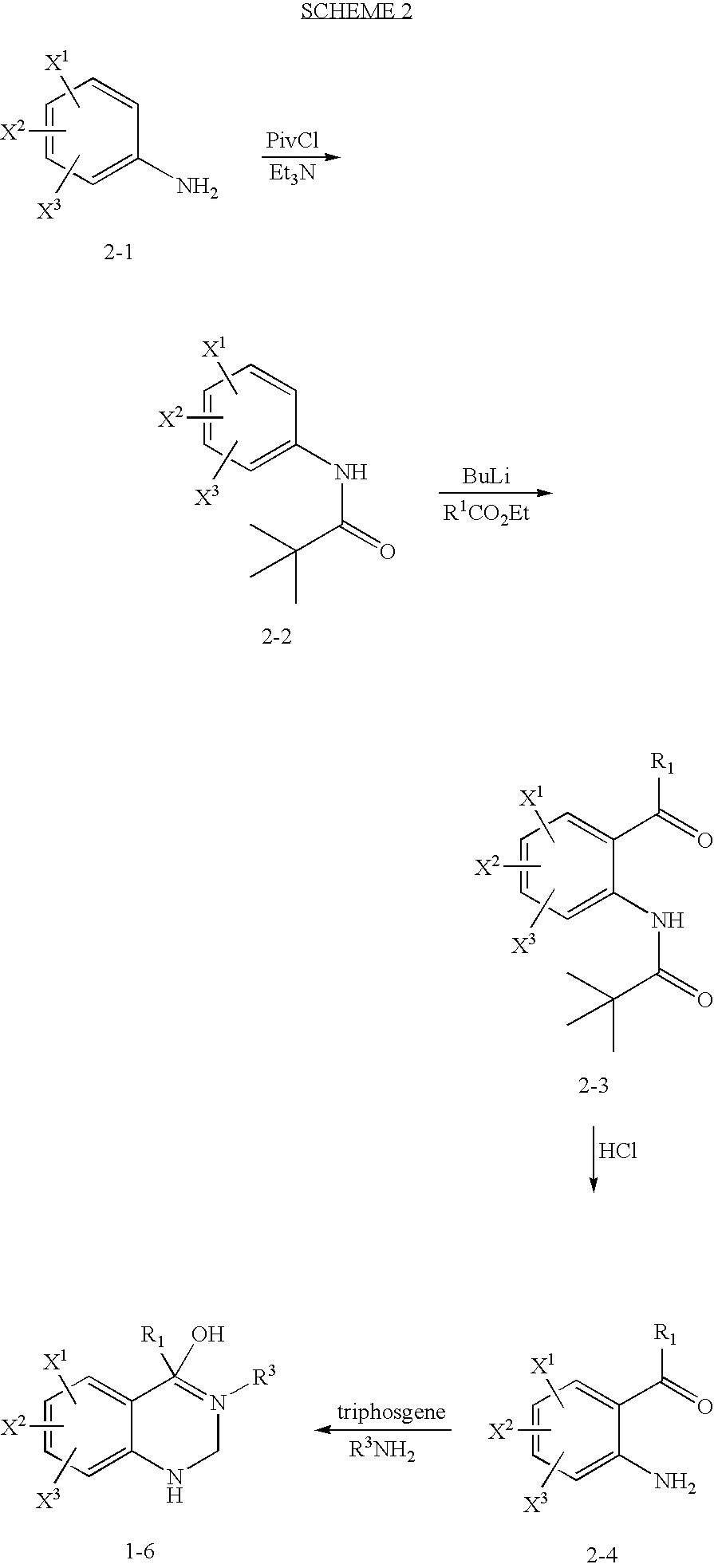Quinazolinone T-Type Calcium Channel Antagonists
a technology of calcium channel antagonists and quinazolinone, which is applied in the field of voltage gated channel proteins, can solve the problems of numerous problems in the known therapeutic regimen for such diseases and disorders, and achieve the effect of treating or preventing
- Summary
- Abstract
- Description
- Claims
- Application Information
AI Technical Summary
Benefits of technology
Problems solved by technology
Method used
Image
Examples
example 1
[0122]
N-(2-benzoyl-4-chlorophenyl)-1H-imidazole-1-carboxamide (3-2)
[0123]To a solution of 2-amino-5-chlorobenzophenone (40 g, 172.7 mmol) in CH2Cl2 (175 μL) was added carbonyldiimidazole (30.8 g, 189.9 mmol). The reaction was heated to 45° C. for 16 h resulting in a white precipitate. The reaction was cooled in an ice bath and the precipitate collected by vacuum filtration and dried to give 39.3 g (69.9%) of N-(2-benzoyl-4-chlorophenyl)-1H-imidazole-1-carboxamide as a white solid. 1H NMR (CDCl3, 400 MHz) 8.66 (s, 1H); 7.46 (m, 4H); 7.25 (s, 1H); 7.19 (d, J=6.96 Hz, 2H); 7.15 (s, 1H); 6.94 (m, 2H); 6.76 (d, J=2.29 Hz, 1H). MS (Electrospray): m / z 348.0 (M+Na).
6-chloro-4-hydroxy-4-phenyl-3-(2,2,2-trifluoroethyl)-3,4-dihydroquinazolin-2(1H)-one (3-3)
[0124]To a suspension of N-(2-benzoyl-4-chlorophenyl)-1H-imidazole-1-carboxamide (39.3 g, 120.5 mmol) in THF (200 mL) was added 2,2,2-trifluoroethylamine (14.0 g, 141.0 mmol). The reaction was heated to 50° C. for 16 h. A second portion of 2...
example 2
[0126]
2-amino-5-fluoro-N-methoxy-N-methylbenzamide (4-2)
[0127]To a 0° C. mixture of diisopropylethylamine (34.36 mL, 197.25 mmol) and O,N-dimethyl-hydroxylamine hydrochloride (19.24 g, 197.25 mmol) in CHCl3 (300 mL) was added 2-amino-5-fluorobenzoic acid (25.50 g, 164.38 mmol) followed by EDC (31.51 g, 164.38 mmol). The reaction was stirred from 0° C. to ambient temperature over 2 h and then diluted with CH2Cl2 (100 mL), washed with saturated sodium bicarbonate solution (100 mL) and brine (100 mL), dried over Na2SO4, filtered, and concentrated in vacuo. Purification by normal phase chromatography (3-8% MeOH / CH2Cl2) yielded 2-amino-5-fluoro-N-methoxy-N-methylbenzamide as a yellow oil. 1H NMR (CDCl3, 400 MHz) 7.12 (m, 1H, ArH); 6.93 (m, 1H, ArH); 6.65 (m, 1H, ArH); 3.63 (s, 3H, CH3); 3.35 (s, 3H, CH3); MS (Electrospray): m / z 199.1 (M+H).
(2-amino-5-fluorophenyl)(phenyl)methanone (4-3)
[0128]To a −78° C. solution of 2-amino-5-fluoro-N-methoxy-N-methylbenzamide in THF (100 mL) was added 1...
example 3
[0132]
(2-Amino-5-chlorophenyl)(4-fluorophenyl)methanone (5-1)
[0133]To a 0° C. solution of 1.0M 4-fluorophenylmagnesium bromide in THF (196.6 mL, 196.6 mmol) was added a THF solution (100 mL) of 2-amino-5-chlorobenzonitrile (10.0 gm, 65.5 mmol) over 0.5 h. The ice bath was removed and the reaction stirred at ambient temperature for 17 h. The brown solution was cooled in an ice bath, treated with a drop wise addition of aqueous 1N HCl (300 mL) and extracted with ether (2×250 mL). The combined organic extracts were washed with aqueous 1N HCl (100 mL), water (2×150 ml), saturated aqueous sodium bicarbonate (150 ml), brine (100 mL), dried over MgSO4, filtered, concentrated in vacuo to 30 mL and diluted with 60 mL hexane. The resulting precipitate was filtered to give (2-amino-5-chlorophenyl)(4-fluorophenyl)methanone as a yellow solid.
[0134]1H NMR (CDCl3, 400 MHz) 7.67 (m, 2H); 7.37 (d, J=2.38 Hz, 1H); 7.25 (m, 1H); 7.16 (m, 2H); 6.70 (d, J=8.79 Hz, 1H); 5.99 (s). MS (Electrospray): m / z 2...
PUM
 Login to View More
Login to View More Abstract
Description
Claims
Application Information
 Login to View More
Login to View More - R&D
- Intellectual Property
- Life Sciences
- Materials
- Tech Scout
- Unparalleled Data Quality
- Higher Quality Content
- 60% Fewer Hallucinations
Browse by: Latest US Patents, China's latest patents, Technical Efficacy Thesaurus, Application Domain, Technology Topic, Popular Technical Reports.
© 2025 PatSnap. All rights reserved.Legal|Privacy policy|Modern Slavery Act Transparency Statement|Sitemap|About US| Contact US: help@patsnap.com



